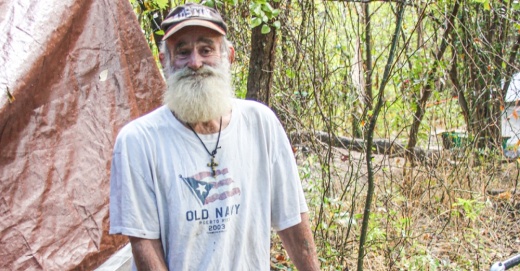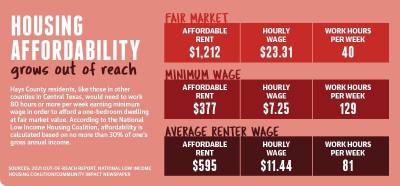San Marcos City Council entered into an interlocal agreement with Texas State University on Sept. 7 to begin studying the issues and needs of people without housing in San Marcos and to provide a needs assessment of the population.
While the study from Texas State is just getting off the ground, there is some data that the local Homeless Outreach Mitigation & Emergency Center gathered in coordination with the Texas Homeless Network this year—a point-in-time, or PIT, count.
There were 107 people counted as homeless in 2021, all of whom resided in or around San Marcos.
The council has recently faced backlash when two council members—Shane Scott and Saul Gonzalez—placed an item on the Sept. 21 agenda to discuss a possible renewal of city ordinances, which had been on the books since 1999, that would ask police to step up enforcement on camping and panhandling.
Many residents took notice of the agenda item and showed up to voice opposition to the idea of cracking down on homeless residents.
Scott said the purpose of putting it on the council’s agenda was to open further discussion on the issue and see if some solutions could be reached to get people without housing in better living conditions.
“I don’t think we can wait anymore to guide out-of-the-box thinking on the homeless ... the law enforcement side of it is limited. Since that doesn’t
work, why don’t we focus on things that do work. I would like to maybe find property to actually have something built,” Scott said.
Currently Southside Community Center, an affiliate of the United Methodist Church, is the only shelter for those without housing in San Marcos, as the city and Hays County do not operate a shelter.
Despite the fact that the city does have prohibitions on camping in public locations, panhandling citations or arrests are rarely used by law enforcement, Director of Public Safety Chase Stapp said.
“Generally, we warn people about the behavior and ask them to move along, and that generally happens, and they are able to get that done without citations being issued. And that’s been our approach for many years,” said Stapp, who also noted that it is difficult to justify issuing citations or tickets to people who officers know will not be able to afford to pay them.
Finding our neighbors
For the PIT count survey, volunteers have to find and speak to those experiencing homelessness and gather information that will detail their basic demographic data, such as their age, gender, and race or ethnicity. The survey also determines if individuals have family living without housing with them or if they are alone, and whether they have severe mental illness or dependency issues with alcohol or drugs.
The PIT count data for Hays County does not list very many people on it that volunteered to say they have mental illness. H.O.M.E. Center President Hannah Durrance said that due to stigma or an inability to recognize it on their own, many people experiencing homelessness do not volunteer that information.
“That’s where it changes a little bit, because most of the individuals don’t admit to us that they have a mental or intellectual disability,” Durrance said. “So it is a lot easier for them to admit that they have a health issue than it is for them to say, ‘Well yeah, I’ve been diagnosed with something in the past’ or ‘I’m not getting treatment.’ Most of the people who have a mental illness that’s severe either don’t recognize it or they deny it. So that’s one of the things that is underreported [in the PIT count].”
One person who has experienced homelessness, Jack, spoke to members of the H.O.M.E. Center. He described how he became homeless. He spoke of working on a car he purchased that he could no longer access due to a conflict with the person he bought it from, being a Marine and becoming a musician in San Marcos.
Jack, who might be in his early to mid-60s, said he created different pathways and camping areas in a wooded public space just off Hwy. 80 in San Marcos. Jack weaved together grapevines and shrubs to create partitions and barriers to create a sense of space for anyone that camped there, Durrance said.
Not everyone gets along with each other in these camping areas, and on Sept. 28 Jack was allegedly attacked by another camper and much of his work was set on fire, according to Durrance.
“This breaks my heart. All this stuff built by Jack has been burned out. It was not like this a few days ago when I was here,” Durrance said. “This is not a safe environment for him. One of these guys is a drug addict and he messes with Jack all the time.”
Later that morning, Durrance notified a police officer over the phone who is familiar with the residents of the campsite about what happened to Jack and asked them to look into it.
The Texas Homeless Network screens those surveys to make sure someone counted locally was not screened and counted somewhere else they might have moved from in the state so as not to replicate any numbers. The THN shares all data collected in the state through the Texas Homeless Data Sharing Network. Jack is one of the people who answered a survey.
“Most of the efforts have been concentrated in San Marcos because that’s where most of the unhoused folks are located,” said Tegan Debrock, chair of the Homeless Coalition of Hays County.
Debrock said the organization has reached out to other cities in Hays County but has not gotten much interest in coordinating efforts.
“I did speak with someone on the council from Kyle, but largely their response was, ‘Well there’s only ever maybe one or two folks here, [and] we send them on their way.’ So, largely people concentrate in San Marcos, and that’s why we focus so much on organizing here,” Debrock said.
Not all experiencing homelessness camp
While the H.O.M.E. Center focuses on checking on the unhoused camping community, volunteers, along with a variety of other organizations in Hays County, such as San Marcos Housing Authority, Together for a Cause, the Salvation Army, the Hays-Caldwell Women’s Center and several others, can provide various other forms of assistance. This assistance can include such things as temporary hotel stays and assistance with applying for Social Security and state identification.
Often a lack of identification and paperwork prevents people experiencing homelessness from accessing any resources beyond emergency services, Durrance said.
Durrance said there are about 20 hotel rooms throughout the year being paid for where individuals can live temporarily. The Southside Community Center only has six rooms to offer. Brenda Belt, who is originally from Kentucky, said she came to Hays County originally to stay with family.
She ended up not being able to connect with them and has a variety of medical issues. Her Kentucky driver’s license is expired, and she does not have a social security card or birth certificate. She said she is temporarily staying in a motel and changed her forwarding address to it, but she has not received any bills there. All these things prevent her from applying for Medicaid or disability assistance.
She said she was recently turned away from a hospital while seeking care.
“Even in the state I’m in I was going to try to work part time just to get some money coming in, and I can’t even do that because I [don’t have] an up-to-date ID,” Belt said.
According to the U.S. Department of Education, the numbers begin to add up when residents who have a non-traditional housing situation are counted. All school districts in the United States are required to provide a McKinney-Vento count—the number of students whose parents or guardians answer yes to anything on a questionnaire provided during school year registration that asks if they stay in the same place all the time; share a temporary space with relatives; or if they are couch surfing—meaning they lack any regular, fixed nighttime residence. The federal government then uses that data to allocate funding for homeless shelter programs throughout the country.
Those numbers have not been finalized, but current numbers for San Marcos CISD are 71 students, down from 186 last school year. For Hays CISD, that number is 218 students, also down from the 2020-21 school year, according to both districts’ communications departments.
Housing prices continue to grow out of reach for some
Officials said one major barrier to establishing a residence is the amount one income earner needs to make to afford housing, which continues to climb.
According to the 2021 Out-of-Reach Report from the National Low Income Housing Coalition, a worker in Hays County would have to work 129 hours a week at the federal minimum wage to afford a one-bedroom apartment, or make $23.31 an hour at 40 hours a week. The mean renter wage in Hays County is $11.44 an hour, meaning that those who fall in that category could not afford more than $595 a month in rent. Rent affordability is calculated by the National Low Income Housing Coalition to mean one-third of an individual’s income.
To help bridge some of that gap, San Marcos City Council has so far allocated $400,000 of American Rescue Plan Act funding to address homelessness, though it is still holding multiple workshops and conversations to determine how to move forward.
“I think this is the perfect opportunity to set the vision for what we want to do in terms of addressing the needs of our unhoused neighbors,” City Manager Bert Lumbreras said. “I think the city has the opportunity to set the right tone, set the right foundation,” he said.Lumbreras cautioned that it might be ill-advised for the city to move in the direction of an emergency shelter, stating that those shelters tend to not address core problems associated with homelessness. “This is not an issue that just the city of San Marcos by ourselves can undertake. It’s got to be collaborative with active partners that have a heart and passion and that have resources to be able to learn to solve it.”Police Chief Stan Standridge told the council to look into the THN’s coordinated efforts with the Built for Zero Campaign, a nationwide coalition that works to end homelessness. The campaign has worked with local leaders around the country to end homelessness.
Prior to taking the helm in San Marcos, Standridge was police chief of Abilene. According to Built for Zero, the city achieved “functional zero” veteran homelessness in 2019 and “functional zero” chronic homelessness in 2020, one of just a handful of communities in the country to do so.
“The Built For Zero campaign will give you a roadmap or pathway, so to speak, of achieving [zero] homelessness in our community,” he said.







